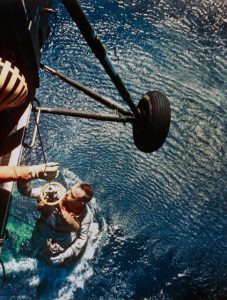58 years ago, Alan Shepard was launched into history aboard a Mercury Redstone rocket (originally used by the U.S. Army for missiles), becoming the first American astronaut in space.

On May 5, 1961, Shepard rocketed into space inside his Freedom 7 capsule. The sub-orbital flight, which lasted just over 15 minutes, reached an altitude of 116 miles, and proved that NASA could send humans into space. Katherine Johnson, the trailblazing NASA research mathematician, even ran the trajectory analysis for the flight!
Freedom 7 splashed down near the Bahamas and was recovered by the nearby U.S. Navy carrier Lake Champlain.
Shepard was a hero. Upon his return, he was invited to the White House where President Kennedy bestowed him with the Distinguished Service Medal. The mission was hailed as a success and a ticker-tape parade in New York City celebrated Shepard’s daring accomplishment.
The victory came less than a month after Soviet cosmonaut Yuri Gagarin orbited the Earth.
Although Shepard’s flight did not accomplish this feat, it established the United States as a contender in the heated Space Race and paved the way for future spaceflights like John Glenn’s historic orbital flight, and the Apollo lunar landing missions further down the road.
According to Space.com, unlike the Soviet success with Gagarin which was kept top secret, Shepard’s entire flight was broadcast on live television for the world to see.
Shepard was a part of the “Mercury 7”, the first 7 astronauts selected for the first national space program, Project Mercury, which was born on Oct. 7, 1958. America’s first astronauts included Shepard, Gus Grissom, John Glenn, Gordon Cooper, Walter Schirra, Scott Carpenter, and Deke Slayton.
Project Mercury had three main objectives according to NASA: to orbit a crewed spacecraft around the Earth, to investigate the ability of a human to function while in space, and to recover both the astronaut and crew capsule safely upon their return to Earth. In just 5 short years all three objectives of the program were met.
Rear Admiral Shepard, the first American in space, and one of only twelve people to walk on the surface of the moon, died on July 21, 1998. He is remembered for his first historic spaceflight that captivated the world, and perhaps for becoming the first person to hit a golf ball on the lunar landscape during his Apollo 14 mission.
A national hero, and a true pioneer in the field of space exploration, astronaut Alan Shepard is remembered today for his contributions to human spaceflight history and for inspiring a nation to reach for the moon!
Relive this milestone in American spaceflight history by watching real footage of the event below:









